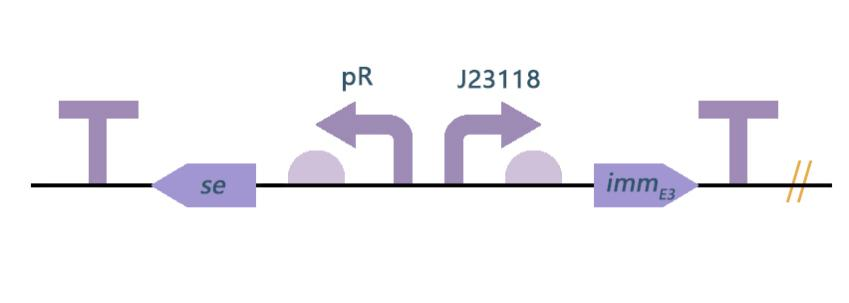Part:BBa_K3740050
pR-RBS300-SE-B1006-J23118-RBSII-IMM-rrnB T1
Description
This composite part is a device consisting of SE and IMM, that is used to regulate the expression of SE and IMM.
Sequence and Features
- 10INCOMPATIBLE WITH RFC[10]Illegal EcoRI site found at 2497
- 12INCOMPATIBLE WITH RFC[12]Illegal EcoRI site found at 2497
Illegal NheI site found at 2585
Illegal NheI site found at 2608 - 21INCOMPATIBLE WITH RFC[21]Illegal EcoRI site found at 2497
Illegal BglII site found at 2202
Illegal BamHI site found at 1774 - 23INCOMPATIBLE WITH RFC[23]Illegal EcoRI site found at 2497
- 25INCOMPATIBLE WITH RFC[25]Illegal EcoRI site found at 2497
Illegal NgoMIV site found at 1573
Illegal AgeI site found at 1663 - 1000COMPATIBLE WITH RFC[1000]
2021 SZPT-China
Biology
This composite part is a device consisting of SE(BBa_K3740042) and IMM(BBa_K3740034), that is used to regulate the expression of SE and IMM.
Usage
We connected pR-RBS300-SE-B1006 (BBa_K3740057) and J23118-RBSII-IMM-rrnB T1 (BBa_K3740053) to the expression vector pSEVA331 by standard assembly, and transfer the connection mixture into G. hansenii ATCC 53582. When the engineering bacterialysed, SE protein can be released to kill Pseudomonas aeruginosa specifically.
Characterization
1. Verification of SE protein antibacterial performance of composite parts
Method: PAO1 growth inhibition verification. Lysate supernatant of G. hansenii ATCC 53583 containing SE proteins that were expressed under control of different RBS were obtained by sonication and centrifugation and further purified by infiltration with micro-pored membrane. Then, lysate supernatant in different groups was individually mixed with PAO1 culture, and incubated at 30℃ for 12 hours. SYNERGY H1 micro-plate reader was used to measure the OD600 to determine the effect on PAO1 growth.
Inhibition zone experiment: 3 μL of the lysate supernatant containing SE protein was dropped on FAB plate with PAO1.
As shown in Figure 4 (a), we found that the OD600 values of PAO1 strains cultured with supernatant from the 4th colony bacterial lysate, were much lower than that of PBS in the control group. This proves that lysate supernatant of the 4th colony had a remarkable inhibitory effect on the growth of PAO1. Consistent with this result, lysate supernatants from all the G. hansenii isolates have formed inhibition zone on the plate spread with PAO1, yet with different sizes. The 4th isolate displayed the most significant antipseudomonal effect, while the control, the 9th colony had no effect. These results show that expression of SE protein was successfully induced in G. hansenii ATCC 53582. Besides, by adjusting the RBSs upstream the SE-encoded sequence, we screened and identified that the 4th strain, pR-RBS300-SE-B1006-J23118-RBSII-IMM-rrnB T1-pSEVA331-G. hansenii ATCC 53582-4# exhibited the optimal antipseudomonal effect.
References
[1] Gupta S, Bram E E, Weiss R. Genetically programmable pathogen sense and destroy. [J]. Acs Synthetic Biology, 2013, 2(12):715-723
| None |


